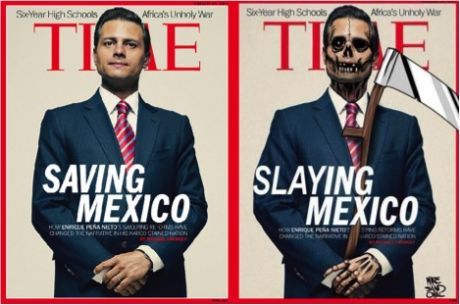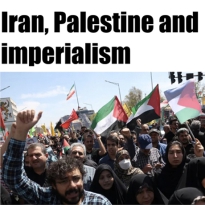Features
You are here
Mexico: mass protests against gangster capitalism

December 17, 2014
The false image of Mexico as a neoliberal success has been shattered. Mass protests against the mass murder of students have exposed NAFTA’s legacy of poverty and violence.
Kidnappings, mass graves, torture, beheadings, government collusion with organized crime—if this were not an investment-friendly NAFTA partner there would perhaps be calls for sanctions, NATO intervention or “boots on the ground.” However, this is Mexico, a trading partner and neoliberal model, so North American pundits and politicians remain silent.
Leading up to the recent disappearance and probable slaying of students in Mexico, much of the press was presenting President Enrique Peña Nieto as Mexico’s neoliberal savior, praised for implementing more market reforms and privatization of the energy sector. Time Magazine even featured him on its cover with the headline “Saving Mexico,” drawing outrage from Mexicans who live a very different reality.
Kidnapping and protests
On the night of September 26, police intercepted a bus of students from the Ayotzinapa teachers' college and opened fire, killing two students and injuring 17. During the attack, the police loaded 43 students into trucks and handed them over to the Guerreros Unidos ("United Warriors") gang. The students have not been found, and rather than assuming they are alive, investigators have been looking in mass graves.
There are many unanswered questions, but some important context has been mentioned outside of the corporate press. The victims, all young men, came from some of the poorest regions of Mexico. These students recently began studies at the Escuela Normal Rural, where they were preparing to be teachers. Escuela Normal Rural has a long history of popular education, established in the 1920s following the Mexican Revolution and rooted in social and popular resistance movements of Guerrero (the state in southwest Mexico where the college is located). During the Mexican Dirty War against leftist and student groups in the 1960s and 70s, about half of those disappeared were from the Guerrero State.
In regular tension with state authorities, students of the Escuela Normal have a history of social action—including blocking roads and temporarily overtaking buses—tactics they say are the only way to get the attention of authorities. Since bus companies often pay protection money to gangs, the student campaigns are seen as threatening to organized crime. In 2011, Guerrero State Police shot and killed two students during a rally on the highway. Students have also been active in ongoing protests against Education Reforms where authorities, urged by demands from many business organizations, have used violence and intimidation to repress demonstrations.
While this context does not fully explain the tragedy, it shows it is part of ongoing violence and repression directed against social movements—driven by ideology, power, and profit. The 43 missing students are among tens of thousands of mostly young people murdered and disappeared in recent years in Mexico.
Since the 1990s hundreds of women and girls, many of them factory workers in the maquiladora sweat shops, have gone missing or been found dead near the border town of Ciudad Juárez. The main response from government and media have been to blame gangs and call for more police—using the “war on drugs” to further militarize society. But the latest mass murder shows the full collusion between government, police and gangs.
Months after the disappearance of 43 students in Ayotzinapa, Mexico, protests continue to rage across Mexico and draw international solidarity—with slogans ranging from "Ya me cansé" ("I've Had Enough" or "I'm Tired") to “Fuera Peña” (“Peña must go). This has provoked a crisis of legitimacy for the Mexican state, and exposed the legacy of NAFTA.
NAFTA legacy: gangster capitalism
In Mexico and internationally, the ruling class generally responds to such events with calls for rule of law and police enforcement to confront criminal gangs. But when criminals are in power, rule of law only serves to solidify existing injustice. As stated in the preface to the book Narcolandia: “It is not the mafia that has transformed itself into a modern capitalist enterprise—it is capitalism that has transformed itself into a mafia…political economy has become criminal economy.”
Twenty years ago Bill Clinton proclaimed at the signing of NAFTA that “an economic order that will promote more growth, more equality, better preservation of the environment, and a greater possibility of world peace.” Two decades later, this End of History style rhetoric rings hollow in all NAFTA countries, especially Mexico.
Even in capitalist terms NAFTA has failed to produce growth: out of the 20 Latin American countries, Mexico ranks 18th in GDP growth since 1994, with average annual growth less than 1 per cent. The official poverty rate in Mexico has remained at just over 50 per cent, but the real rate is likely much higher, since GDP and other common indicators are not a measure of health and well-being. NAFTA has also increased inequality—creating new billionaires and artificially high prices for basic commodities like food staples—and destroyed environmental regulation. Agro-industrial imports have forced millions of Mexican farmers off the land, migrating to work in factories or fleeing across the border. Low wages and insecure work have forced many into poverty and the unofficial drug economy.
In a response to Mexico’s crisis, the President said: “Today there are two Mexicos: one that is part of the global economy with growing levels of income, development and well-being; and then there is a poorer Mexico with historical problems that have been unresolved for generations.” In addition to blaming the poor instead of capitalism, his proposed economic reforms and his calls for development of the southwest (the region where the kidnapping occurred) fails to consider that his very notion of “development” may be the underlying problem.
Peña Nieto’s development agenda seems to follow on Vicente Fox’s former Plan Pueblo Panama, advancing export-industrial, maquiladora style economies in the region. The result is a kind of uneven anti-development: speculative criminal economies rather than a stable agriculture or industrial base. By some estimates, 500,000 people are employed directly or indirectly in the Mexican drug trade, a $25 billion a year business. Enormous profits backed by heavily armed cartels created state entrenched narcopower. The newspaper La Jornada estimates 62 per cent of municipal, ministerial, and federal agents are linked to cartels. This is why Peña Nieto’s 10-point, legalistic response to the most recent tragedy can be viewed with scepticism. Mexico does not lack laws or a robust Constitution, at least on paper. But without systemic change with economic justice, it is all meaningless.
The gangsters north of the Mexican border
Far from being a Mexican problem, the biggest criminals are north of the Mexican border. The “war on drugs” and North American security agenda have militarized Mexico to repress dissent. Under the 2007 Mérida Initiative, the US transferred over $3 billion in training, equipment and intelligence to Mexican police and military. This military assistance has not been used to fight drug cartels as it is claimed, but to arm the police against social movements that pose a threat to corporate power.
Rather than take tens of thousands of civilian deaths as an indication policies are not working, US and Mexican officials have paradoxically stated violence is a sign of success against organized crime. DEA head Michele Leonhart was quoted saying they “are like caged animals, attacking one another.”
Canada, meanwhile, has pursued taxpayer funded police training programs with the Mexican narco-state, while cutting development assistance related to human rights and poverty alleviation. Over 2,500 Canadian companies operate in Mexico, from the garment industry to mining. Due to its drive to mine and extract resources on Indigenous land, the Canadian government refuses to investigate more than a thousand missing and murdered Indigenous women within its own borders—and its no surprise the Canadian government is ignoring the deaths and disappearances of people in Mexico, dying while Canadian corporations profit.
Resistance and solidarity
The protests in Mexico are only intensifying as further scandals emerge. In search of the missing students, even more mass graves have been uncovered, prompting the protest slogan “there will not be a mass grave big enough to shut us all up.” Adding to the fury, Peña Nieto and his ministers have faced scandals over conflicts of interest over their lavish mansions.
The mass protests in Mexico are linked to alternate modes of development that communities are fighting for—including food sovereignty, ecological protection, and communal land rights. Many among Mexico’s poor, Indigenous, and working classes are searching for alternatives, from autonomous regions to vigilante self defense groups. Students from the Escuela Normal have called on people to participate in protests. Solidarity rallies have also been held in numerous US cities.
Social movements in Mexico have a long history—from the revolution in 1910, the student movement in the 1960s, the Zapatista uprising in the 1990s, and the mass protests in 2006. But unless such actions force systemic change and confront transnational capital, violence and injustice will continue.
Section:










